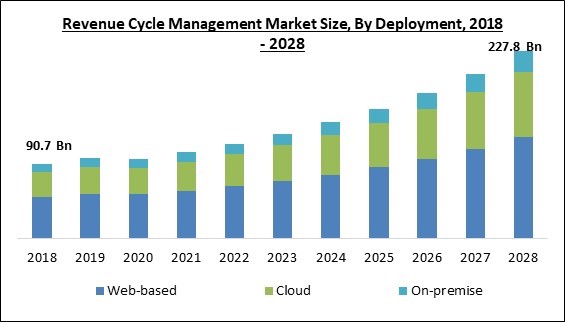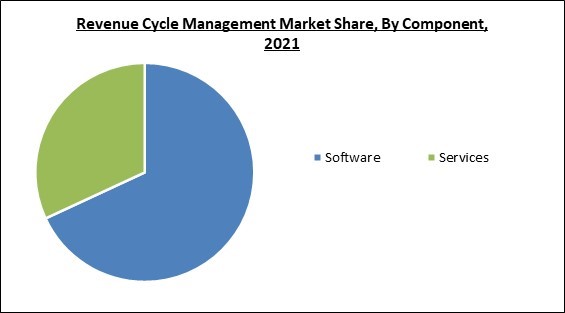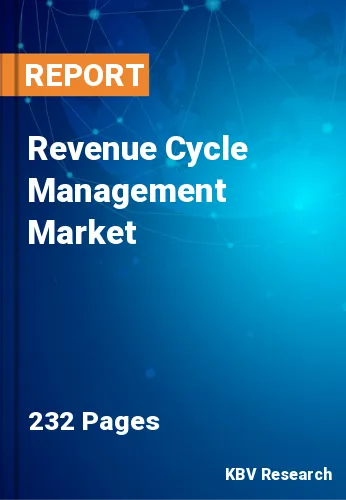The Global Revenue Cycle Management Market size is expected to reach $227.8 billion by 2028, rising at a market growth of 12.0% CAGR during the forecast period.
Revenue cycle management (RCM) is the procedure used to track patient revenue from the initial visit or interaction with the healthcare system for the final balance payment. This method assists healthcare institutions and private clinics in streamlining their business operations. In addition, RCM solutions assist providers in managing and improving revenue cycle operations such as medical coding & billing, electronic health records, patient insurance eligibility verification, clinical documentation, and claims and rejections management.

The demand for revenue cycle management has expanded due to regulatory compliance's growth-fostering effects. In addition, the increasing need for workflow optimization in healthcare organizations, coupled with the development of innovative synchronized management software systems, contributes to expanding the market for revenue cycle management.
Moreover, the rising demand for cloud-based solutions is a significant development driver for the revenue cycle management market. In contrast, expanding outsourcing services in emerging countries is anticipated to generate profitable prospects for the market in the coming years. In addition, a rise in revenue cycle management-related advancements and efforts is predicted to present a market expansion opportunity.
The growth of the revenue cycle management market can be ascribed to an upsurge in government initiatives to promote the deployment of RCM solutions, a rise in revenue loss attributable to billing errors, and process optimization in healthcare companies. Accurate processing of medical claims is essential for healthcare providers' revenue. To improve financial performance, a healthcare business must uphold a quality revenue cycle and insurance billing.
Accounts receivable (A/R) management or denial management comprises the revenue cycle management team. Most care providers are losing money due to claim denials and their refusal to submit or delay in submitting refused claims, while hospitals are under increasing pressure to decrease expenses. This has enabled organizations to specialize in revenue cycle management services.
The COVID-19 pandemic has caused unprecedented effects on the majority of healthcare sector and resulted in substantial changes to the regular operation of healthcare systems. Several obstacles negatively impacted healthcare providers' and payers' revenue earnings or inpatient volume. The growth in demand for advanced and innovative RCM solutions prompted key players to develop features like payer connect, reporting, analytics, remote coding services, and audit and compliance to increasing revenue generation and productivity. Thus, this has become one of the most important causes for the growth of the market for revenue cycle management amid the global health crisis.
To safeguard patient information and guarantee that claims management proceeds without hiccups, the healthcare sector has undergone several regulatory framework adjustments. One such law, the Health Insurance Portability and Accountability Act of 1996 (HIPAA), safeguards the privacy rights of health information by protecting electronically protected health information (e-PHI). In addition, this law maintains the availability, privacy, and integrity of e-PHI. The expansion of the revenue cycle management market is fueled by all of these reasons taken collectively.
The increase in healthcare expenditures is attributable to increased medical prices, the expansion of the covered population, and the demand for more advanced healthcare services. In addition, an increase in healthcare expenditures in countries such as Germany, France, Sweden, the United Kingdom, and others in this region is the primary reason driving the expansion of revenue cycle management in Europe. In addition, the high spending patterns of hospitals and physicians in the emerging economies of Asia-Pacific and LAMEA are anticipated to drive demand for revenue cycle management. This supports the growth of the regional market.
One of the primary issues faced by the market is the reluctance to abandon conventional revenue cycle management practices. This is due to a lack of trust and faith in new technologies, which might result in the modification of traditional workflows. In addition, the expense of transitioning to the new system is a significant element that impedes the implementation of the most recent technology. Inadequate standards and technical assistance might also hinder the adoption of new technology. This constrains the expansion of the market.
Based on end-user, the revenue cycle management market is segmented into hospitals, physicians, diagnostic laboratories and others. The hospital segment held the highest revenue share covered a considerable revenue share in the revenue cycle management market in 2021. This is a result of the growing number of regulations and guidelines that regulatory bodies are creating regarding patient safety. Hospitals are using RCM solutions more frequently due to the increased demand to improve productivity and efficiency by streamlining hospital procedures. The RCM software used in most hospitals is integrated, bringing all patients and providers together on a single platform.

By deployment mode, the revenue cycle management market is fragmented into on-premise, and cloud. The cloud segment recorded a remarkable revenue share in the revenue cycle management market in 2021. Physicians, hospitals, and diagnostic & ambulatory care centers have increased their usage of cloud-based revenue management solutions as a result of an increase in the transfer of critical and confidential information. These solutions provide payers and providers with enhanced remote control over application access and confidential patient information.
On the basis of type, the revenue cycle management market is bifurcated into integrated, and standalone. The standalone segment garnered a significant revenue share in the revenue cycle management market in 2021. Although independent software gives more comprehensive reporting and advanced features, healthcare professionals frequently favor it. As they have extended lifecycles and customizable characteristics, standalone systems are employed to improve the process flow and also have a high level of efficiency, which is anticipated to foster segment expansion.
Based on component, the revenue cycle management market is divided into software and services. The software segment registered the largest revenue share in the revenue cycle management market in 2021. This results from the widespread implementation of RCM software to prevent healthcare fraud and save administrative costs. In addition, in the past few years, as a response to the digitalization of processes and streamlining to enhance patient care, a growing volume of data has contributed to adopting solutions; thus, healthcare analytical software solutions are being employed more often and gaining momentum.
| Report Attribute | Details |
|---|---|
| Market size value in 2021 | USD 104.9 Billion |
| Market size forecast in 2028 | USD 227.8 Billion |
| Base Year | 2021 |
| Historical Period | 2018 to 2020 |
| Forecast Period | 2022 to 2028 |
| Revenue Growth Rate | CAGR of 12% from 2022 to 2028 |
| Number of Pages | 232 |
| Number of Table | 430 |
| Report coverage | Market Trends, Revenue Estimation and Forecast, Segmentation Analysis, Regional and Country Breakdown, Companies Strategic Developments, Company Profiling |
| Segments covered | Component, Deployment, End-use, Type, Region |
| Country scope | US, Canada, Mexico, Germany, UK, France, Russia, Spain, Italy, China, Japan, India, South Korea, Singapore, Malaysia, Brazil, Argentina, UAE, Saudi Arabia, South Africa, Nigeria |
| Growth Drivers |
|
| Restraints |
|
Region wise, the revenue cycle management market is analyzed across North America, Europe, Asia Pacific and LAMEA. In 2021, the North America region led the revenue cycle management market by generating highest revenue share. Its position as a pioneer in the creation of the IT framework for the healthcare industry is one of the key elements influencing this expansion. The revenue cycle management market in the region offers lucrative growth potential because of the large number of massive hospitals and health systems, favorable regulations, growing geriatric population, and growing need to reduce healthcare costs across the nation.
Free Valuable Insights: Global Revenue Cycle Management Market size to reach USD 227.8 Billion by 2028
The market research report covers the analysis of key stake holders of the market. Key companies profiled in the report include Quest Diagnostics Incorporated, Athenahealth, Inc. (Veritas Capital), GE HealthCare Technologies, Inc., Experian PLC, R1 RCM, Inc., Epic Systems Corporation, eClinicalWorks LLC, McKesson Corporation, Oracle Corporation (Cerner Corporation), and AllScripts Healthcare Solutions, Inc.
By End-use
By Deployment
By Component
By Type
By Geography
The global Revenue Cycle Management Market size is expected to reach $227.8 billion by 2028.
Grown healthcare spending resulting in increased preference to outsourced RCM solutions are driving the market in coming years, however, Unwillingness to abandon customary practices restraints the growth of the market.
Quest Diagnostics Incorporated, Athenahealth, Inc. (Veritas Capital), GE HealthCare Technologies, Inc., Experian PLC, R1 RCM, Inc., Epic Systems Corporation, eClinicalWorks LLC, McKesson Corporation, Oracle Corporation (Cerner Corporation), and AllScripts Healthcare Solutions, Inc.
The Web-based segment acquired maximum revenue share in the Global Revenue Cycle Management Market by Deployment in 2021 thereby, achieving a market value of $123.4 billion by 2028.
The North America market dominated the Global Revenue Cycle Management Market by Region in 2021, and would continue to be a dominant market till 2028; thereby, achieving a market value of $105.9 billion by 2028.
Our team of dedicated experts can provide you with attractive expansion opportunities for your business.

